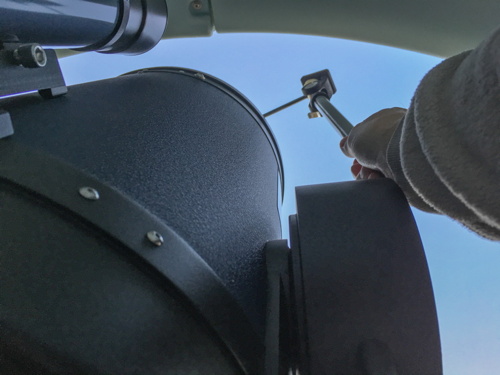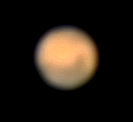Telescope Collimating;
Imaging: Moon, Mars, Saturn
Posted: 22 May 2016
Friday, 20 May 2016, was clear but too windy to open the observatory. Saturday, 21 May, was still windy during the daytime and clouds came in mid-day.
|
Open: Saturday, 21 May 2016, 1905 MST Temperature: 82°F |
Session: 965 Conditions: Partly cloudy, mostly calm |
Equipment Used:
12" f/8 LX600 w/StarLock
Wireless AutoStar II handset
2" 24mm UWA eyepiece
2" 30mm eyepiece
1.25" 15mm eyepiece
1.25" 9.7mm eyepiece
2" 2X PowerMate
1.25" 3X TeleXtender
Camera:
iPhone 6s Plus
D7200 DSLR
The main goal for the night was to improve the 12" telescope optical collimation. Due to the large size of the telescope I needed a guide to which of the three adjustment screws needed to be turned. When I successfully collimated my previous 8" telescope I was able to use a finger in front of the objective, but I could not do that with the 12". So I used a monopod with the handle as a substitute for my finger. I did some practicing to ensure I could safely hold the monopod in position while looking through the eyepiece:

1922 MST: sunset:

1927 MST: LX600 ON, StarLock OFF. Viewed Jupiter, 102X. The four Galilean Moons and the Great Red Spot were visible. Switched to 251X. The collimation was not terrible so I expected I would have to make only some minor tweaks and that it would go quickly. I then did a "finger test" with the monopod to ensure that the "finger" was visible when an object was out-of-focus; it was.
1944 MST: began collimating the 12" LX600 using the star Spica. Started with a magnification of 325X and the star diagonal. Did some adjustments and checked the collimation at 325X without the diagonal. Make another slight adjustment. Switched to Rho Boötes with a magnification of 754X, with and without the diagonal. Maybe a few more adjustments. Checked the collimation mask at 163X. Better but still not perfect. Check Mars and Jupiter at various magnifications. Seeing wasn't ideal and I still wasn't happy with the collimation. Back to Spica with a magnification of 203X and did some more collimation, with and without the star diagonal. Viewed Jupiter and Mars; views were better, but still not quite perfect. Decided to end collimation work after 2.5 hours, which had been way longer than I expected. Would do some more collimation work on the next session.
2223 MST: viewed the Moon just a few hours after Full, 81X. A slight terminator was visible. Took this handheld iPhone 6s Plus afocal 81X:

Then did some iPhone afocal 542X + one Variable Polarizing Filter filter, SteadyPix adapter, Camera app slo-mo (240 fps) video, 10 seconds. This is a stack of 2483 video frames showing Syrtis Major on Mars:

Removed the filter and did a 10 second video (30 fps), 542X, of Saturn. Stack of 313 frames:

2310 MST: ended iPhone imaging. Viewed Mars and Saturn, 203X. Seeing was still not very good, and neither was the collimation. Did some quick checks of the collimation using Spica, 203X. Definitely need to improve the collimation on the next session.
I then took two photos of the Moon, Mars, Saturn, and the star Antares, D7200 DSLR, f/5, 1/200sec and 1/2sec, ISO 400, 60mm, White Balance Auto. The two images were merged to show the Moon, planets, and some stars:

Mouseover or tap on image for labels
|
Close: Saturday, 21 May 2016, 2358 MST Temperature: 60°F |
Session Length: 4h 53m Conditions: Mostly clear |
Comments are welcome using Email. Twitter users can use the button below to tweet this report to your followers. Thanks.
Cassiopeia Observatory Home Page
Copyright ©2016 Michael L. Weasner / mweasner@me.com
URL = http://www.weasner.com/co/Reports/2016/05/22/index.html

